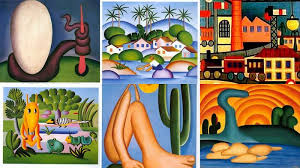Montana Ray at The Point:
 The Confederate immigrants didn’t impose their way of life in São Paulo’s rural interior. On neighboring plantations, enslaved women were raising the white artists who would become the country’s major modernists. Brazil’s most famous modernist painter, Tarsila do Amaral, muse of Antropofagia, grew up on her family’s coffee plantation, a half hour’s drive from the American colony. Antropofagia was a movement of “cultural cannibalism” based on a caricature of the Tupi indigenous people as cannibals; elite white Brazilians would “cannibalize” French styles in the production of Brazilian subject matter: Black people. A year before her death, do Amaral explained that the subject for her first anthropophagic painting, A Negra (1923), was a “female slave” she remembered from her youth, and described in vivid detail I won’t repeat how the woman had stretched her breasts so that she might breastfeed while working. Chattel slavery legally ended in Brazil on May 13, 1888, when do Amaral was one year old, so her explanation was technically anachronistic. Either emancipation passed without notice, or her family’s plantation hummed along under a new economic arrangement so closely resembling slavery that she still referred to wage workers as “slaves.”
The Confederate immigrants didn’t impose their way of life in São Paulo’s rural interior. On neighboring plantations, enslaved women were raising the white artists who would become the country’s major modernists. Brazil’s most famous modernist painter, Tarsila do Amaral, muse of Antropofagia, grew up on her family’s coffee plantation, a half hour’s drive from the American colony. Antropofagia was a movement of “cultural cannibalism” based on a caricature of the Tupi indigenous people as cannibals; elite white Brazilians would “cannibalize” French styles in the production of Brazilian subject matter: Black people. A year before her death, do Amaral explained that the subject for her first anthropophagic painting, A Negra (1923), was a “female slave” she remembered from her youth, and described in vivid detail I won’t repeat how the woman had stretched her breasts so that she might breastfeed while working. Chattel slavery legally ended in Brazil on May 13, 1888, when do Amaral was one year old, so her explanation was technically anachronistic. Either emancipation passed without notice, or her family’s plantation hummed along under a new economic arrangement so closely resembling slavery that she still referred to wage workers as “slaves.”
more here.
